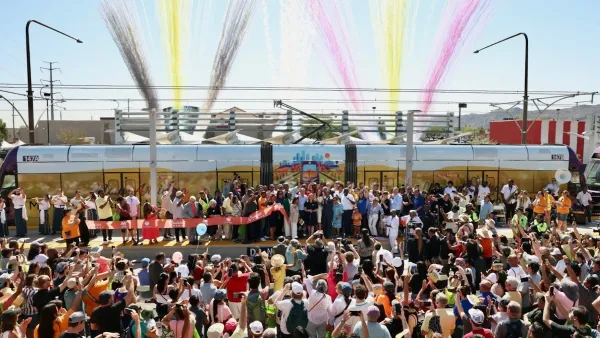Phoenix voters, by 55 percent according to preliminary results, chose to increase their sales tax from .4 to .7 percent on Tuesday, continuing until 2051 to pay for $17 billion in transportation improvements.
Overcoming Republican opposition, "Phoenix voters approved a major boost in transportation funding for new light rail lines, bus expansion and street improvements over the next several decades in Tuesday's election," writes Brenna Goth for The Republic (AZCentral.com).
About 35,000 votes have yet to be counted, or about 26 percent of the total ballots cast. Another update won't come until Friday, according to the City Clerk Department. [Check election results here.]
The measure will triple Valley Metro light rail mileage, as noted here earlier.
The city-only measure [PDF], mistakenly described as a Maricopa County measure here earlier, was an affirmation of support for Phoenix Mayor Greg Stanton, a staunch advocate of Prop 104, and the city council.
“This is a great night for the future of the city of Phoenix,” Stanton said, referring to the Prop 104 victory. The Democratic mayor, who was also on the ballot, won a second term in a landslide, reports The Republic's Dustin Gardiner,
"Phoenix’s sales tax rate is 8.3 percent and will increase to 8.6 percent Jan. 1 with the transit tax increase," adds Goth.
FULL STORY: Phoenix voters pass Prop. 104 transit tax

Planetizen Federal Action Tracker
A weekly monitor of how Trump’s orders and actions are impacting planners and planning in America.

Chicago’s Ghost Rails
Just beneath the surface of the modern city lie the remnants of its expansive early 20th-century streetcar system.

San Antonio and Austin are Fusing Into one Massive Megaregion
The region spanning the two central Texas cities is growing fast, posing challenges for local infrastructure and water supplies.

Since Zion's Shuttles Went Electric “The Smog is Gone”
Visitors to Zion National Park can enjoy the canyon via the nation’s first fully electric park shuttle system.

Trump Distributing DOT Safety Funds at 1/10 Rate of Biden
Funds for Safe Streets and other transportation safety and equity programs are being held up by administrative reviews and conflicts with the Trump administration’s priorities.

German Cities Subsidize Taxis for Women Amid Wave of Violence
Free or low-cost taxi rides can help women navigate cities more safely, but critics say the programs don't address the root causes of violence against women.
Urban Design for Planners 1: Software Tools
This six-course series explores essential urban design concepts using open source software and equips planners with the tools they need to participate fully in the urban design process.
Planning for Universal Design
Learn the tools for implementing Universal Design in planning regulations.
planning NEXT
Appalachian Highlands Housing Partners
Mpact (founded as Rail~Volution)
City of Camden Redevelopment Agency
City of Astoria
City of Portland
City of Laramie




























